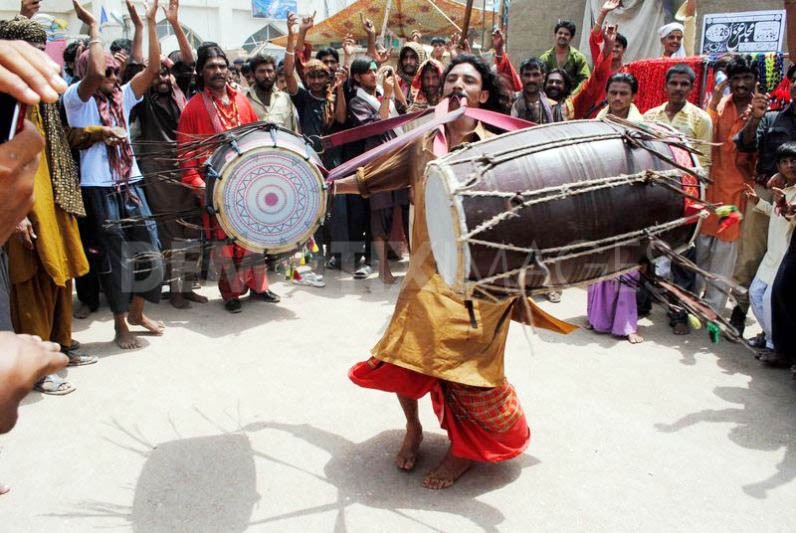
Preparations are under way at Sehwan to celebrate one of the biggest festivals in the country

Like most of our cultural heritage, the general information about people and places is derived from oral sources. Very little has been documented in script or pictorial forms; as most has travelled down from generation to generation or "seena ba seena".
As one of the biggest festivals in Pakistan is under way at Sehwan on the urs of Shahbaz Qalandar, one wonders what the contribution of Shahbaz Qalandar was that warrants such a big gathering of musicians who pay homage to him. Whether his contribution to music was of a patron or that he was more actively involved in music-making like the other sufi from Sindh who followed him many centuries later, Shah Abdul Lateef Bhitai, is open to speculation.
As in almost all cases concerning music, the documentation that can back this idea is scant and if the reality of continuous practice of musical rendition and performances at his shrine for centuries is considered solid evidence, the proof of a living tradition points to him having strong links with the art form.
Naubat is played on the shrine, either solo or collectively but it is a little difficult to trace the history as to when it started being played on the shrine. It is an accepted belief that it had been played since the days of Shahbaz Qalandar himself. Played twice in twenty four hours -- at dusk and dawn, and on both occasions, it is accompanied by dhamaal. According to many, dhamaal too started with Shahbaz Qalandar and the tradition has continued till the present. It is a dance performed on the rhythmic variations of the naubat and is probably the most artistic manner of losing one’s identity and merging with the collective and bigger identity -- by invoking a state of trance.
In the last five decades or so, Laal Meri Pat Rakhio Bhala Jhule Laalan has introduced Shahbaz Qalandar to the urban audiences, and all kinds of versions have been in currency since. It is very difficult to say who the composer was and how old it is. Master Ashiq Hussain, who composed a myriad of unforgettable melodies for the Pakistani cinema for almost five decades, claimed that he composed what could safely be called the world’s most famous dhamaal for Pakistan cinema. This composition has propelled numerous artistes from the subcontinent to international fame. According to Hussain, he composed this dhamaal in just a few minutes at the request of Saghar Siddiqui, an eminent poet who wrote it. Once a recognised music director in Pakistan, Hussain lived in a slum inside Bhati Gate in old Lahore. Hussain’s contribution to Pakistan’s silver screen was eclipsed as he gained very little appreciation in contrast to his contemporaries, like Nisar Bazmi, Rasheed Atray or Robin Ghosh. Echoed gloriously across the world in the voices of Noor Jehan, Nusrat Fateh Ali Khan, Runa Laila, Jagjit Singh, Abida Parveen, Damadam Mast Qalandar could be Hussain’s most popular number.
However, there have been many other claimants to this composition. It is said that Reshman, on the urs of Shahbaz Qalandar in the 1960s, was heard singing this along with other compositions and this is what attracted the attention of Salim Gilani who was considered a connoisseur of music and at that time worked as one of the bosses of Radio Pakistan. In the 1960s Rubina, who later came to be known as Rubina Qureshi because of her marriage to Mustafa Qureshi, also used to sing this composition from Radio Pakistan Hyderabad. Various roving minstrels like Faqir Abdul Ghaffor and Soong Fakirs have also sung the same composition with variations on the urs of many Sufis in Sindh.
There are three credible documented sources on Shahbaz Qalandar. First, of Richard Burton who called him a Jelali Fakir. These Fakirs were generally poor who lived in a hand-to-mouth situation. The Jamali Sufis in Sindh were a more respectable class than their Jelali brethren. The latter openly dispensed with the formalities of religious worship.
Second, Athar Abbas Rizvi for whom the establishment of the Sufi khanqah synchronised with the penetration of the Qalandria movement that was divided into several branches as the Hydaris and the Jawalqis. Their reputation to perform miraculous deeds filled both the Soharwardia and the Chistiyya khanqah with consternation. They were deeply devoted to music and loved to sing songs eulogising Ali and Ahle Bait. It was, however, the khanqah of Shahbaz Qalandar in Sehwan which until this day has been radiating the love of Ali and Ahle Bait through Persian and Sindhi songs.
The third source is H.T. Sorley for whom the existence of a number of cultured and thinking men imbued with the highest tenets of Sufi philosophy was beyond doubt but very little was known about them, and the best known of the early ones was Sayid Usman Shah Marwandi who became famous as Lal Shahbaz with a popular shrine at Sehwan. He was a Qalandar and attained a great reputation for sanctity in his lifetime and after his death. During the annual fair, thousands of Hindus and Mohammedans camped round the tomb, mixing freely and singing the sufi songs that ever melt the heart. He also left behind a number of works which formed part of the academic courses like Mizan-e-Sarf, Ajnas or Munshaib, rules for the formation of the increased derivatives, and the Kisim-i-doyyum for the irregular verbs. These works by Lal Shahbaz were written in Persian while Akds, another of his work written in mixed Arabic and Persian, deals with the permutation of letters.